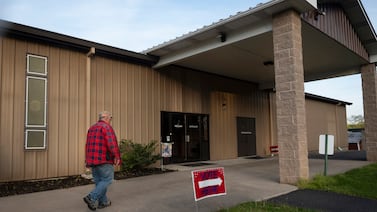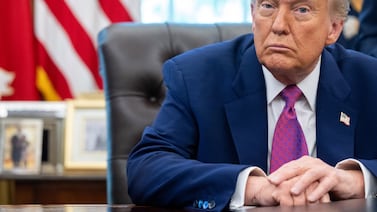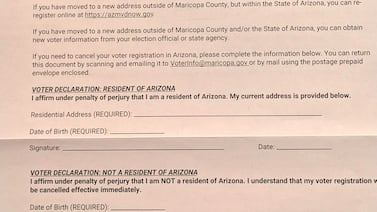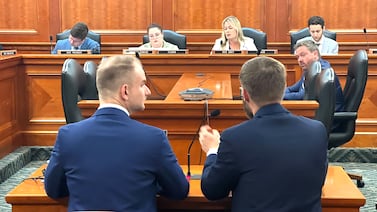Votebeat is a nonprofit news organization reporting on voting access and election administration across the U.S. Sign up for Votebeat Arizona’s free newsletter here.
Arizona voters were anxious heading into Tuesday’s election, thinking about voting problems the state has experienced in the past and primed to worry about election security.
As in other states, several counties received bomb threats at polling places and election offices during the day that, in some cases, affected casting or counting ballots, even though officials quickly said the threats were not credible. There were also some long lines. But for the most part, election officials declared the day a success.
The exception was on the Navajo Nation in northeast Arizona, where problems with ballot printers in Apache County led to long lines. A judge ordered some of the county’s locations to stay open two hours past the originally scheduled close time to ensure that voters could cast ballots.
Elsewhere, in Maricopa and Pima counties, voters took a long time to complete the two-page ballot, contributing to lines that at times wrapped around buildings and kept some people waiting for more than an hour. As the polls approached closing time, voters at a voting location in a Phoenix church found chairs to rest in as they waited in a line of dozens of voters.
The pressure was on in the battleground state, which was expected to help decide the outcome of the presidential election. That’s especially true for Maricopa County, the country’s largest swing county, where mistakes in running the election fueled lawsuits from losing candidates in 2022.
Media from across the globe were staked out in a giant temporary tent outside the county’s election center in downtown Phoenix all day Tuesday, waiting for news about security threats or problems at the polls. But at an 11 a.m. news conference, Supervisor Bill Gates had little to talk about other than what he called the “Chamber of Commerce” 74-degree weather.
“Things are moving very smoothly out there today,” Gates said.
College students at the state’s three large public universities faced the longest of lines, and at two of those locations — the University of Arizona in Tucson and Northern Arizona University in Flagstaff — election directors said that misinformation distributed by an unknown individual or group played a part.
Many of the students in line, they said, believed that they could cast a federal-only ballot in the county, even though they were registered to vote in another county or state.
These voters were told that they could vote a provisional ballot, which takes more time for poll workers to administer.
In Tucson, in Pima County, the wait got so long that Elections Director Constance Hargrove said she had to send out additional equipment. The line at the location near the University of Arizona campus at one point was 2½ hours long, she said.
“I don’t know why they were pushing that,” she said of the false information.
Other than that, she said, she was “happily surprised,” at how voting went.
At Paradise Valley Community College, a high-traffic voting location in North Phoenix, a DJ played “Mambo No. 9″ Tuesday morning as campaign volunteers tried to flag down voters walking to the voting line, which snaked along the side of the building.
After years of partisan battles over election administration, some voters made a point of saying they were still skeptical of the system.
A voter on her way out told Paul Carver, who was wearing a red MAGA hat at the Republican legislative district’s booth, that she would be praying for positive results. He said he was getting a lot of that.
Carver said that even though the day was going smoothly for voters, he understood why many still didn’t trust the system. “No one has faith,” Carver said. “We have to find a way to get them faith.”
Bomb threats across the state, and the country
The first of the bomb threats named four polling places in Navajo County, including locations on the Navajo Nation and Hopi Reservation, according to Secretary of State Adrian Fontes.
Fontes said that these were “unsubstantiated threats” and he had “no reason to believe that any sort of polling workers are under any kind of jeopardy.”
Fontes said that the threats, reportedly of Russian origin, were connected to those in other states. The FBI announced on Tuesday that multiple states were seeing threats, “many of which appear to originate from Russian email domains.”
“None of the threats have been determined to be credible thus far,” the news release stated.
Fontes later confirmed that La Paz County’s elections center had received a similar threat.
Herald Review Media reported that there was one at the Cochise County Election Department, and ABC15 reported that there was one at Maricopa County Recorder’s Office as well. Both were deemed not credible, although media reports said the offices were both evacuated as a precaution.
Fontes later said results from La Paz and Cochise counties would be delayed, though he didn’t immediately attribute that to the bomb threats.
Judge keeps Apache County locations open late
Just before 10 a.m., in northern Arizona, Apache County Elections Director Rita Vaughan said she was about to drive out to polling places to fix widespread problems with the county’s ballot-on-demand printers.
Vaughan said all voting locations had pre-printed emergency paper ballots available, and no voters should have been turned away.
But Katherine Belzowski, an assistant attorney general for the Navajo Nation Department of Justice, said that poll workers told some voters to leave and come back later. That’s challenging for some voters who live a great distance from the polling place.
Belzowski also said that some locations ran out of these emergency ballots and voters were then only able to cast ballots using an accessible voting device, which created long lines.
She said that there were two- to three-hour lines in some locations, and one voter filled out an affidavit stating that they waited 3½ hours to vote.
In a hearing in Apache County Superior Court just before 7 p.m., attorneys for the Navajo Nation told Judge Michael Latham that voters waited outside polling places for hours in the cold weather.
An attorney for the Navajo Nation told the judge the county could have avoided this problem by testing the printers.
But a lawyer representing the county told the judge that the problems were fixed early in the day, and all voters were able to vote.
While the Navajo Nation wanted all polls on the reservation to stay open late, Latham said that he would require only nine out of the county’s 44 precincts to stay open until 9 p.m.
Jen Fifield is a reporter for Votebeat based in Arizona. Contact Jen at jfifield@votebeat.org.




